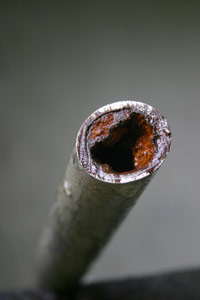
Do you know what your water pipe is made of and how safe it is? Although galvanized (zinc-coated) pipe is still considered to be a safe transport material for drinking water, there are some potential health concerns if the water supply is corrosive due to its acidic condition (low pH). Public water supplies treat their water to make it essentially non-corrosive—so this should not be a concern if you are on a public water system. The concern is not for zinc or iron that may be leaching from the pipe, but for lead and especially cadmium, the two other heavy metals that may be present as impurities in the zinc used for the galvanizing process.
The primary drinking water standards for lead and cadmium are 0.015 and 0.005 mg/L, respectively. If you are on a private well water system where the plumbing is galvanized pipe and the water frequently has a slightly bitter taste, you should have your water tested. Private well is at a high risk of being contaminated. A zinc concentration of more than 5 mg/L will give water a bitter astringent taste but is not a health risk. The EPA has set a secondary contaminant level of 5 mg/L for zinc because of how it affects taste.
Analysis and treatment of the contaminants include many factors that contribute to corrosion and the leaching of contaminants from drinking water distribution systems. The principal factors are the type of materials used, the age of the plumbing system, the stagnation time of the water, and the quality of the water in the system, including the pH value. Metal leaching will be affected differently by each of these factors. Using lead as a trigger to initiate corrosion control programs in a drinking water distribution system, activity levels have been developed for both residential and non-residential buildings.

The implementation of these action levels is expected to help drinking water suppliers determine the source of lead and use corrosion control to reduce its concentration. Residential monitoring will seek to identify sources of lead in both the distribution system and the residential plumbing, whereas non-residential monitoring will focus primarily on the source of lead within the building.
Its effects on distribution systems and potential impacts on the health of the populations are complex and varied. Corrosion in drinking water distribution systems may occur with all types of materials, including metals, cement, and polyvinyl chloride, and can increase the leaching of contaminants from these materials. There is no single, reliable method to measure corrosion in drinking water distribution systems. Although corrosion itself cannot readily be measured, the levels of lead at a consumer's tap can be used as an indication of corrosion.
The health effects are often stated as there are no direct health effects linked to corrosion in distribution systems. However, corrosion may cause the leaching of contaminants that would be a concern for the health of Canadians. The main contaminant of concern is lead, which is used as the trigger to initiate corrosion control programs. The drinking water guideline for lead, established based on health effects in children, is 0.010 mg/L. Other contaminants that can be leached as a consequence of corrosion in drinking water distribution systems include copper and iron. Guidelines for copper and iron are based on aesthetic considerations such as color and taste. Copper has an aesthetic objective of #1.0 mg/L and is generally considered to be non-toxic except at high doses, in excess of 15 mg/day. Iron has an aesthetic objective of 0.3 mg/L in drinking water.
However, you should be concerned about potential cadmium and lead contamination if your water has more than 1.0 mg/L of zinc. When zinc is detected in tap water above 1.0 mg/L, the most likely source of the zinc is corrosion of galvanized piping. Normal concentrations for zinc in groundwater are usually below 0.1 mg/L. If the zinc level is high, have your water tested by a lab that has the capability of measuring lead and cadmium at the levels set for EPA drinking water standards mentioned above. Make sure to use a stagnant water sample that has been in your plumbing system for at least six hours for this type of test. The best treatment alternative is to reduce the corrosiveness of the source water.



